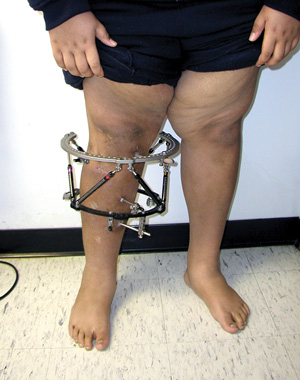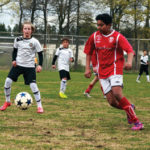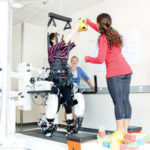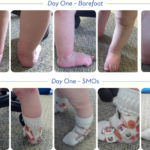
An adolescent male patient with left-sided Blount dis- ease who continued to gain weight despite realign- ment of his leg. (Photo courtesy of Sanjeev Sabharwal, MD, MPH.)
Weight loss requires other tactics
By Hank Black
Surgical correction of the varus alignment that is characteristic of Blount disease does not lead to greater patient activity or reduction in body mass index (BMI), according to a recent study.
“Many parents and physicians see excess weight as a product of immobility due to limb deformity and believe if the limbs were aligned properly, the child’s activity level would increase and obesity would resolve. We conducted a retrospective study to answer that question,” said study coauthor Sanjeev Sabharwal, MD, MPH, professor of orthopedic surgery and director of pediatric orthopedics at Rutgers-New Jersey Medical School in Newark.
Blount disease occurs in early-onset and late-onset forms, with some authors recognizing an intermediate (juvenile) type. The disease is characterized by progressive multiplanal deformities such as tibial varus, procurvatum, and internal torsion, along with limb shortening. The result can be gait deviations and limb-length discrepancy (LLD), which may contribute to premature knee osteoarthritis.
Children with Blount disease tend to be heavier than their peers and have higher rates of obesity. In a 2007 study published in the Journal of Bone and Joint Surgery, Sabharwal and colleagues found a significant relationship between BMI and severity of radiographic deformities in children with early-onset Blount disease, but not in those with late-onset disease.
Some milder cases of early onset disease may spontaneously resolve, and long-leg braces may be helpful in some young children. After age 4 years, however, surgery to restore limb alignment and correct LLD is utilized more frequently.
The current Rutgers study, which was published in the March 2014 issue of the Journal of Pediatric Orthopaedics, assessed 51 children with Blount disease (23 early onset, 28 late onset). The 47 who had gradual surgical correction with external fixation also received six to eight weeks of inpatient rehabilitation that included dietary control and nutritional counseling. They were followed postsurgery for an average of 48 months.
The surgical treatments (osteotomy, growth modulation, or both) significantly improved mechanical axis deviation and LLD. BMI, however, increased relative to preoperative measurements in 76% of the children. At follow-up, the average BMI of the cohort had increased from 35 preoperatively to 38, and the number of morbidly obese (BMI ≥ 40) children had increased from 12 to 20.
“Now we have more information for parents, but unfortunately not good news,” Sabharwal said. “We could only influence the child’s diet for the rehabilitation period, and it’s also difficult to impact long-standing eating habits when so many patients are economically disadvantaged minorities with limited food choices.”
Brian Shaw, MD, an associate professor at the University of Colorado in Denver and Children’s Hospital Colorado in Aurora, said he was not surprised by the findings but agreed the information could be useful for parents.
“The study answered a valid question for patients with Blount disease, although I wouldn’t have expected any other result—previous studies of orthopedic procedures such as knee joint replacement have shown no positive effect on BMI or obesity,” Shaw said. “However, we can now counsel patients more knowledgeably that lower BMI should not be a part of expectations of treatment. The study does support research into whether bariatric surgery and other nonorthopedic surgery methods can address patients’ obesity and lack of activity.”
In fact, the one patient who demonstrated the greatest BMI and weight reductions in the Rutgers study was an adolescent who refused the orthopedic procedures and underwent bariatric surgery.
“Perhaps weight-loss surgery before or after realignment surgery may be an option for some,” Sabharwal said, “but it’s clear that [realignment] surgery alone is not enough.”
Future research might offer additional insights.
“Our study had no control group for comparison, so it would be interesting to do a prospective study comparing these patients either with Blount patients not undergoing a weight-reduction program or compare their activity level with other obese children who have normal limb alignment,” Sabharwal said.
Orthopedic surgeon John G. Birch, MD, of the Texas Scottish Rite Hospital in Dallas, said he is pleased that doctors are using growth-modulation techniques for lower leg alignment.
“Deliberate deceleration of growth on the tibia’s outer part so the inner part will have the power to grow into alignment produces less morbidity than osteotomy,” Birch said. “A well-designed trial of long braces for Blount disease would be useful, [but] it would be very difficult to get off the ground since this is not a common condition.”
Hank Black is a medical writer in Birmingham, AL.
Sources:
Sabharwal S, Zhao C, Sakamoto SM, et al. Do children with Blount disease have lower body mass index after lower limb realignment? J Pediatr Orthop 2014;34(2):213-218.
Sabharwal S, Zhao C, McClemens E. Correlation of body mass index and radiographic deformities in children with Blount disease. J Bone Joint Surg Am 2007;89(6):1275-1283.
Birch JG. Blount disease. J Am Acad Orthop Surg 2013;21(7):408-418.





